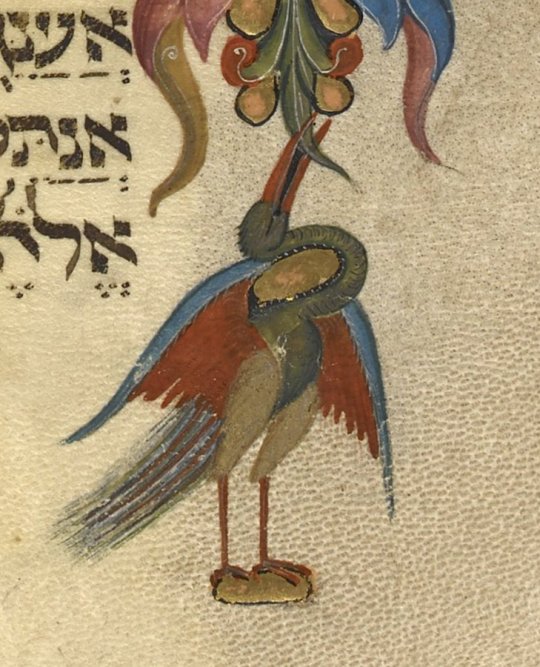#manuscript monday
Text

640-year-old fly, anyone?
We're not sure how long this fly has been in this 14th-century notary's notebook, but it was a favorite among the students who spotted it in class a few weeks ago.
La Turade, Bernard de. [Notarial Registry]. 1383-1393. VAULT DC95.A2 N6 1383
#manuscript monday#medieval manuscript#bookhistory#fly#mizzou#special collections#libraries#university of missouri#rare books#history#books#things found in books
368 notes
·
View notes
Text
Happy #InternationalCheetahDay!
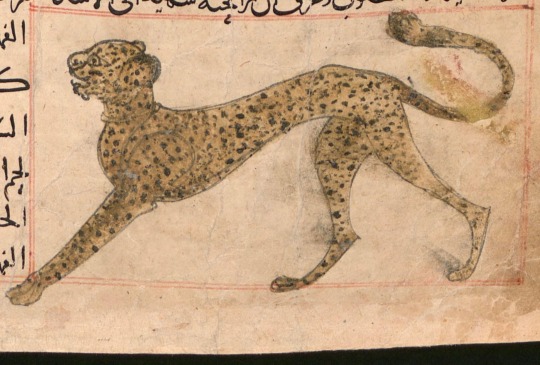
Here is the cheetah in Zakariya al-Qazwini's 'Aja'ib al-Makhluqat wa Ghara'ib al-Mawjudat (The Wonders of Creatures and the Marvels of Creation), an important work of Islamic cosmography which was probably first written in the 1260s, and for centuries after was reproduced across the Islamic world. This illuminated manuscript copy was made in Wasit, Iraq in 1280 CE and is the earliest known surviving version.
#animals in art#animal holiday#cheetah#feline#wild cat#Islamic art#Wonders of Creation#illuminated manuscript#illustration#natural history art#al-Qazwini#Manuscript Monday#International Cheetah Day
348 notes
·
View notes
Text
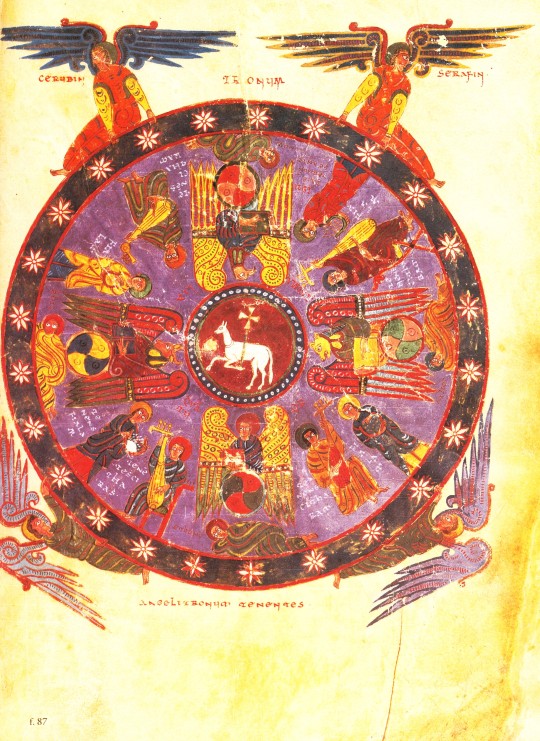

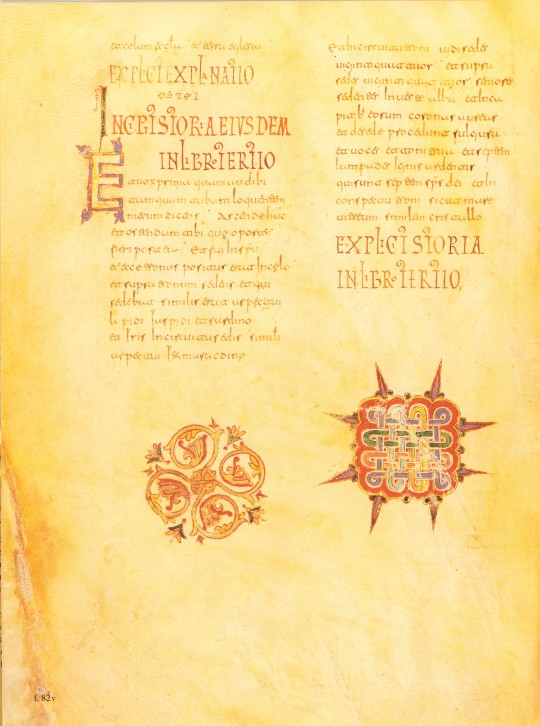
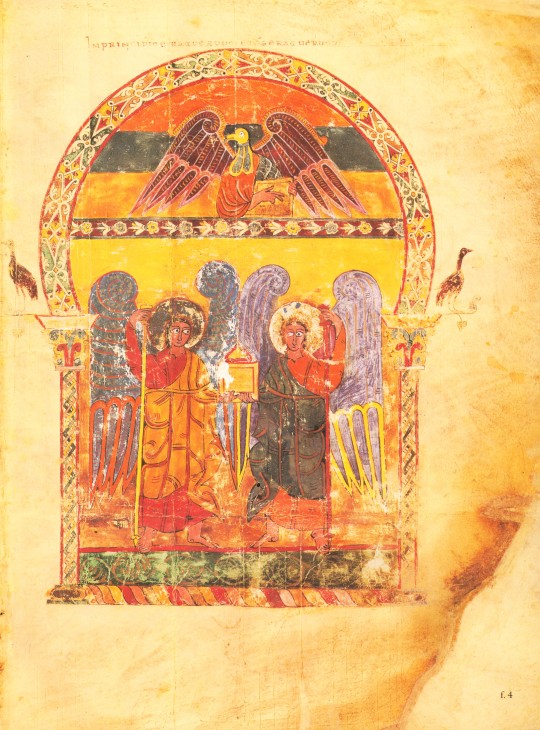




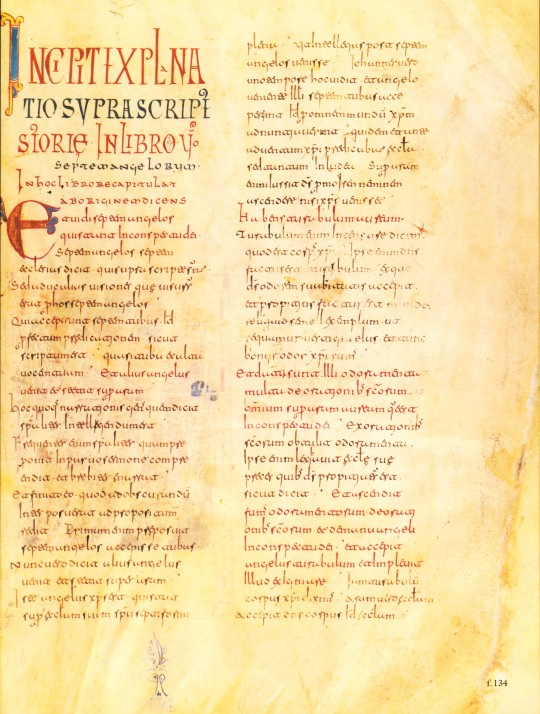
Welcome to Manuscript Monday!
In this series we will periodically focus on selections from our manuscript facsimile collection. Today we present selections from the Morgan Beatus Manuscript, reproduced as A Spanish Apocalypse, The Morgan Beatus Manuscript in New York by George Braziller, Inc. in association with the Pierpont Morgan Library in 1991. The original manuscript, made around 10th century CE at the scriptorium of San Miguel de Escalada in Spain by a monk named Maius, is the earliest surviving illuminated version of the monk Beatus of Liébana's commentary on the biblical Book of Apocalypse (also known as the Book of Revelation). The text of the Book of Revelation makes up the first part of the manuscript, and Beatus’s commentary comprises the second part. The Book of Revelation tells of the end-times in Christianity, during the final judgement of humanity by God. The story within this Biblical book was also seen by those living during the Latin medieval era as representative of the beginning of something new: God’s celestial kingdom. Due to this view of the book, many artists incorporated imagery from this part of the Bible in their work.
Produced in Al-Andalus, or Muslim-ruled Spain, the artistic style of this work combines both Muslim and Christian visual traditions to create a beautifully illuminated manuscript that supplements the commentary by the monk. This artistic style is known as the Mozarabic, which comes from the Arabic mustaʿrib, meaning ‘Arabicized’. Interestingly, this style of art can only be seen in Christian religious art and architecture from Spain at the time, as non-religious artistic objects made by Christians look so similar to Islamic versions of the same works that they cannot be identified as intentionally Christian. Some key Islamic artistic elements within the manuscript include buildings with horseshoe arches, intricate geometric and vegetal patterns as borders for larger images, and the large, bulging eyes of the illustrated animals.
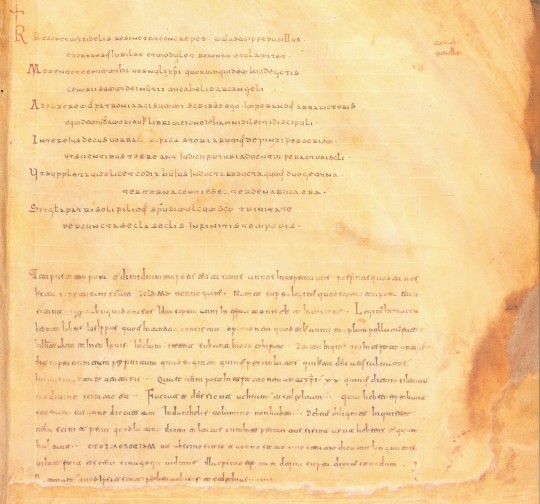
Another interesting aspect of this specific manuscript is the colophon at the end of the manuscript. It tells readers about the circumstances surrounding the creation of this book, including the maker, the patron, the year it was made, and an explanation about why Maius created the manuscript ("I write this . . . at the command of Abbot Victor, out of love for the book of the vision of John the beloved disciple. As part of its adornment I have painted a series of pictures . . . so that the wise may fear the coming of the future judgement of the world's end."). Colophons in medieval manuscripts are not usually as detailed, so the inclusion of all this information contributes greatly to the knowledge and history surrounding the Morgan Beatus Manuscript.
View more Manuscript Monday posts.
– Sarah S., Special Collections Graduate Intern
#manuscript monday#manuscripts#morgan library#morgan beatus manuscript#Beatus of Liébana#Spain#Christian art#Mozarabic#Islamic art style#facsimilies#Spanish art#Medieval art#Spanish medieval art#A Spanish Apocalypse#George Braziller#illuminated manuscripts#Sarah S.
132 notes
·
View notes
Photo


53 notes
·
View notes
Text
I need to hear the 4 exclusive tracks like right fucking now…
#ups says they will be here on Monday…#the manuscript#the bolter#the black dog#the albatross#taylor swift#the tortured poets department
56 notes
·
View notes
Text
Bread and Eggs
(NOT A PR0MPT)

******
It started with the ringing of Villain’s phone. He wasn’t surprised to see Hero’s name pop up. He admired the too-small circle with her picture on it. It was impossible to tell by looking at the emblem, but Villain knew it was a picture from their first date.
To think it had been five years ago...
Villain’s picture on Hero’s phone had been a more recent photo, one from their engagement. An image of him kneeling with the classic black velvety case. It was warm the day of their engagement- Villain didn’t dare propose on a cold day; it would have led to an obvious refusal.
He used to joke that warmth was the only reason Hero even liked him. “You scorn me constantly,” Villain would tease. “You only like me because of the heat I so generously produce.”
“As if you have any control over it! You can’t help that you’re so warm, but it is definitely a plus,” she would ultimately agree.
Now, they were married- and, oh, hadn’t it been a dream? Looking for homes, buying a home, getting groceries, coming home to one another, holding each other at the end of the day. It was all Villain wanted in life, and for so long, it seemed impossible. Yet, here they were; her joyful face was beaming at his under the name ‘Love of my life’.
Answering the phone, Villain jokingly began, “Yes, honey, I remembered to get the bread and eggs.”
The voice that answered wasn’t Hero’s.
***
#not a pr0mpt#this has been in my drafts for quite some time and Im thinking that I should perhaps post it at some point#that some point being now#Bread and Eggs#I'm so creative#Guess who is finally able to take classes again? How many of you knew I was out of classes for months?#None of ya. Because I never explained it.#Basically I was taking classes and then my university was absolutely horrible so I transferred.#After transferring I was able to take two classes before I realized my old school refused to cancel my financial aid which meant I couldn't#use it at my new school. Which meant I could no longer take classes. But I should be able to start Monday. If not Monday then in August :)#Anyway- that's your update from Dee covering the last couple of months in which I have been inactive#I have also been putting a lot of work into my manuscript. I'm just shy of 10k words right now and that's been on top of a lots of life stuf#okie bye! Sorry it's such a short- and relatively incomplete- snippet. I'll try to get something written up for you guys :)
124 notes
·
View notes
Text


Marbled papers used for the cover on Isl Ms 710, Aḥmad al-Ṭabbākh al-Azharī's (أحمد الطباخ الأزهري) Arabic translation of an Italian mathematical compendium, which he titled al-Bahjah al-sanīyah fī mabdaʾ al-ʻulūm al-riyāḍīyah (البهجة السنية في مبدأ العلوم الرياضية)
In his preface, al-Ṭabbākh indicates that he studied Italian and prepared this translation in one of the schools established in Egypt under the educational initiatives of Muhammad Ali Pasha (r.1805-1848).
In his colophon, al-Ṭabbākh indicates that he wrote out this fair copy of his translation on the last day of the month of Dhū al-Qaʻdah 1239 (ca 27 July 1824)
Browse the entire manuscript here
#marbled monday#marbled paper#ebru#ebrusanatı#ابرو#ابر و باد#الايبرو#ابرو باد#manuscripts#Islamic Manuscripts#illuminated manuscripts#special collections#special collections libraries#special collections and archives#archives#libraries and archives#libraries#المخطوطات#المخطوطات العربية#yazmalar#yazma eserler#نسخه های خطی#مخطوطات#المخطوطات الاسلامية#manuscript culture#book arts#arts of the book#paper marbling#decorative paper#Egypt
77 notes
·
View notes
Text
Today's #MedicalMonday is LJS 435, portions of a 15th c. Arabic treatise on surgery with extensive illustrations of surgical implements. Topics covered include incision, perforation, blood-letting, wounds, bone-setting, dislocations, and sprains.
🔗 :
#medieval#manuscript#arabic#surgery#medicine#history of medicine#medical monday#illustration#book history#rare book
101 notes
·
View notes
Photo

Our bell ringer seems very serious. I wonder what she’s ringing the bells for. Any guesses?
A hybrid creature with a wimple and bells
Add MS 42130 f.43r
Source: The British Library.
26 notes
·
View notes
Text
...
#i feel like im trapped in a nightmare rn. like ten min ago i was working on this application#so im summarizing information from an already established project design with no fucking idea if they is the way they want it#knowing im probably doing too much bc the guy was like yea just throw some of these ideas together. like what the fuck do u mean??? u just#gave me the project outline fuck u. and im listening to discordant dreamy vaporwave music and my boss is texting me like#did u reach out to ur last co author abt reading thru ur manuscript bc apparently i misunderstood when she said she last talked to him abt#when he could read it. its due on tuesday. which is also when im traveling home#so fucking i guess i have to hope he looks at it Monday so i cant actually edit in time to submit it that next morning or the night after#i land and get home and hope to god there arent any setbacks in submission#and it feels like a nightmare bc ive managed somehow push myself back to the brink of collapse. im exhausted despite sleeping like 10hrs#last night. at least its raining so i dont have to go sampling tomorrow#im just so tried. this application feels pointless and a waste of time bc i have these fucking manuscripts hanging around my neck. but i#said id apply so im fucking doing it. its close to done. ill finish it tonight but god at what cost#a little more than 48hrs and ill b home. assuming nothing terrible happens. home but not quite off the hook i guess#i just wanna lay on the floor for a while. lay on the floor and sleep for a while#my brain is too heavy for my head#unrelated
6 notes
·
View notes
Text
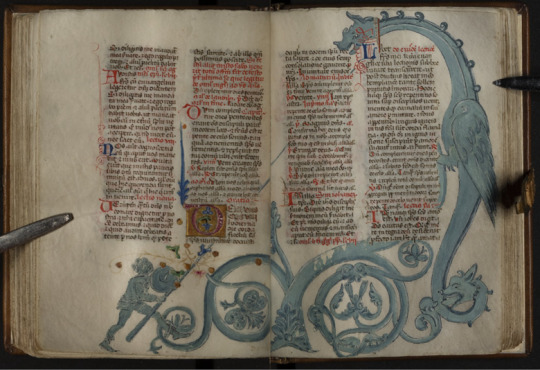
#ManuscriptMonday this week comes from the book we have been referring to as the Blue Dragon Breviary. The manuscript was created in the middle of the fifteenth century in Italy, but the marginal decoration shown above was added much later. Find out more and page through the rest of the manuscript in our Digital Library.
Breviary for Roman use (Blue Dragon Breviary).
#medieval manuscripts#illuminated manuscript#manuscripts#manuscript monday#dragon#art#medieval art#bookhistory#calligraphy#rare books#mizzou#special collections#libraries#university of missouri#history#illustration#fb#private collection#kelli h
307 notes
·
View notes
Text
#ManuscriptMonday:

Ambassadors of the Egyptian Sultan al-Nasir Faraj ibn Barquq Present their Gifts of Tribute, Including a #Giraffe, to Timur in 1404.
illustration from Zafarnama by Sharaf al-Din Ali Yazdishiraz, 1436
Worcester Art Museum 1935.26
#animals in art#illustration#medieval art#Islamic art#medieval manuscript#illuminated manuscript#miniature painting#giraffe#Timur#Tamerlane#Zafarnama#Sharaf al-Din Ali Yazdishiraz#Worcester Art Museum#Manuscript Monday
42 notes
·
View notes
Text

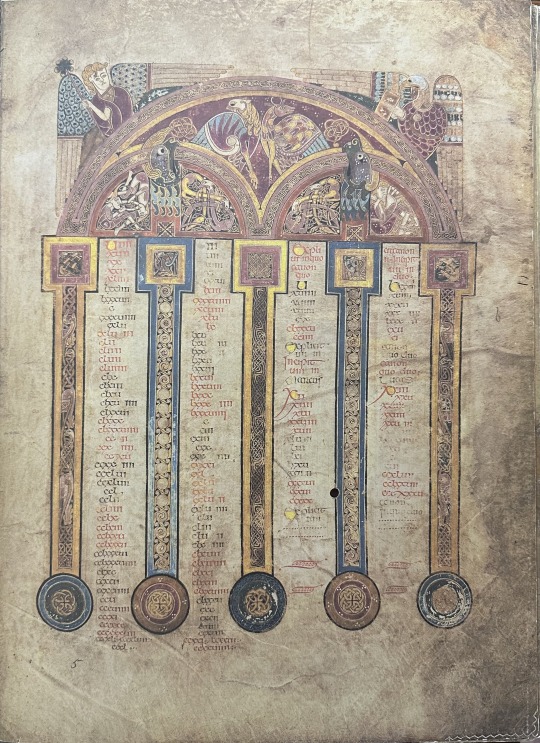



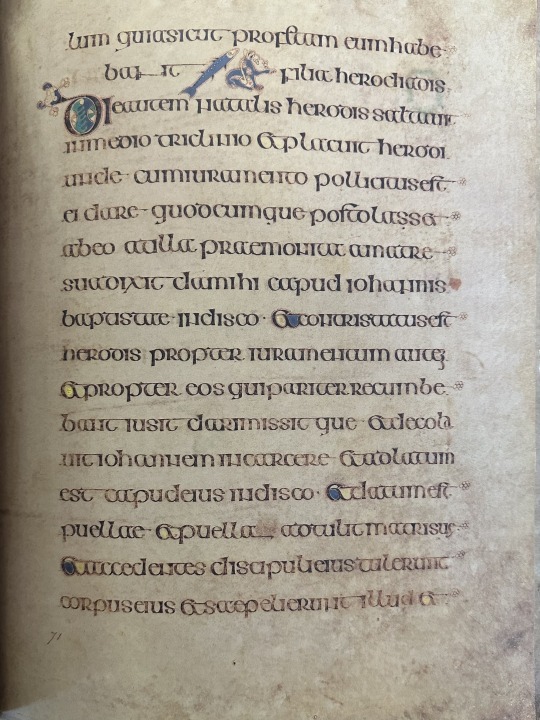

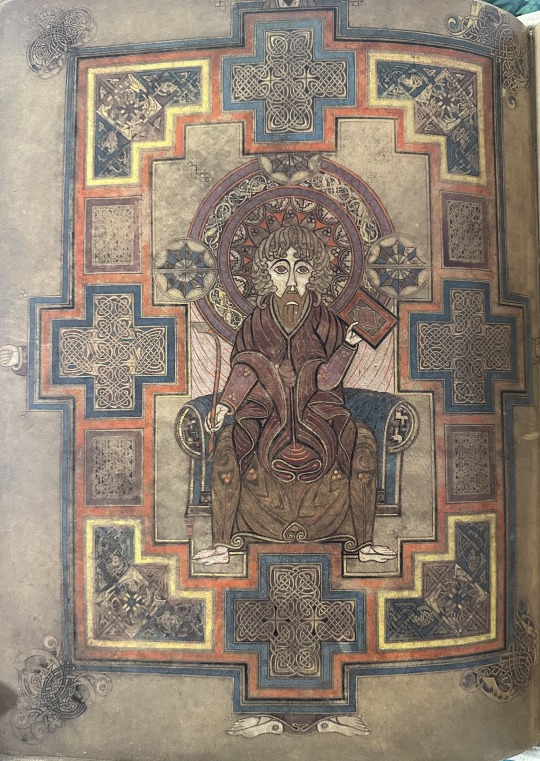
Manuscript Monday
This Insular manuscript was created by Irish Catholics, who were well known to be stewards of knowledge and artistic ability during the ‘dark ages’ of the 6th-10th centuries CE. In particular, the Insular style consists of flattened, two-dimensional figures of people and animals accompanied by elaborate ornamentation throughout its pages. We often see interlacing designs and Celtic knots within this ornamentation and the proportions and rendering of the figures and architecture seen throughout the manuscript are not always realistic. For example, in the Book of Kells, produced around 800 CE by Irish monks in Scottish west-coast island of Iona, the columns holding up the arches on canon tables are circular and would lack structural integrity in the real world, for obvious reasons. We can see the flattened, strange rendering of figures on folio 32v (shown below), which is a depiction of Christ Enthroned. Christ’s knee is lifted to hold up the codex in his hand, but the placement of his knee is anatomically incorrect. We also see the flatness of the figure and the inclusion of ornamentation throughout the image, and we can see even more of this decoration on carpet pages throughout the manuscript. The Insular style was not only limited to manuscripts but was also used in metal objects like broaches, chalices, sculpture, and architecture which are also said to have been inspiration for Insular style manuscripts.

Our copy of the facsimile of the Book of Kells was published by the Faksimile Verlag of Luzern, Switzerland in 1990 and includes a separate volume with commentary edited by the noted Trinity College librarian Peter Fox. If you have the urge to see the original Book of Kells, it is shown in the Trinity College Library in Dublin. The library shows two folios of the manuscript at a time and changes the pages shown every twelve weeks.
View more Manuscript Monday posts.
– Sarah S., Special Collections Graduate Intern
#manuscript monday#book of kells#ireland#kells#illuminated manuscripts#manuscripts#facsimiles#Faksimile Verlag#iona#insular#insular style#carpet page#canon table#trinity college#Peter Fox#trinity college library#dublin#Sarah S.
67 notes
·
View notes
Text

This is the academic good luck post! Reblog to have your reviewers be reasonable human beings!
#jk jk#but fr it was nice to wake up to this manuscript finally getting accepted on a lovely monday morning#took almost 2 years but the reviewer suggestions DID mostly make it better#and we're feasting on that sweet sweet impact factor 😌#academia#professuffering
0 notes
Text
*on the verge of a breakdown* but I stay silly
#im fine its just some jokey jokes#my manuscript hangs in the balance 🙃#cant do anything about it til monday so i remain silly#shitposting#personal
1 note
·
View note

